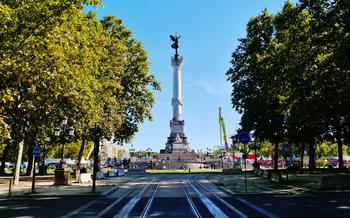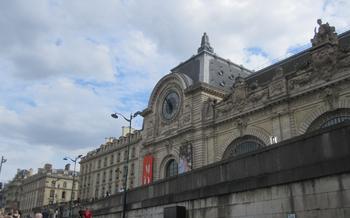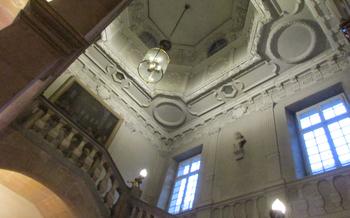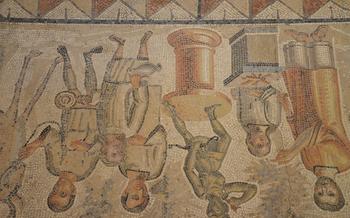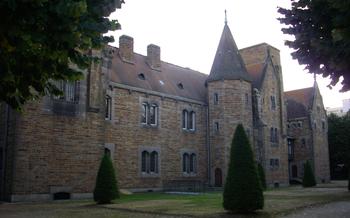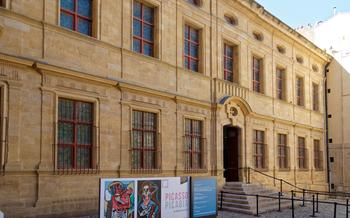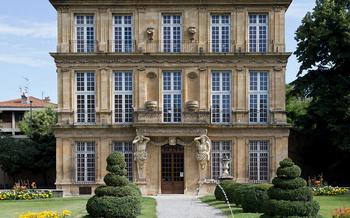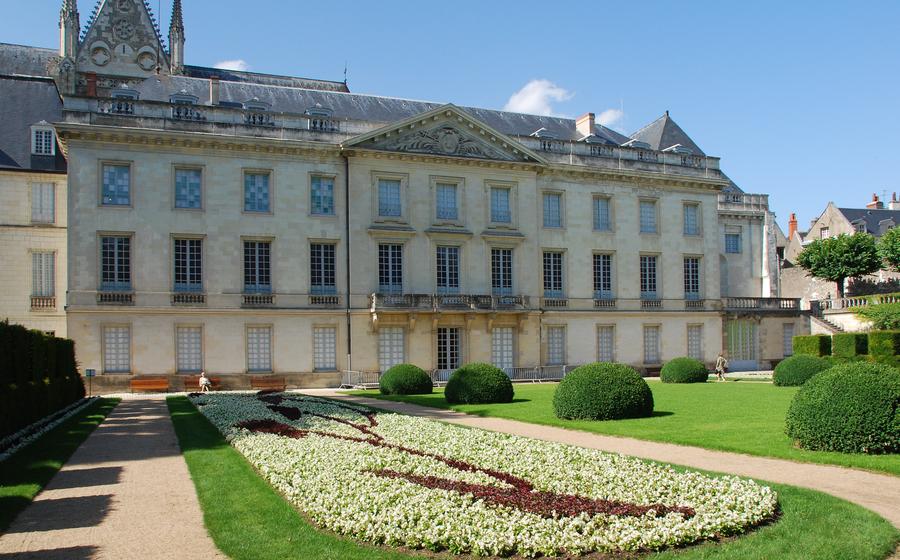
Musée des Beaux Arts de Tours
- Musée des Beaux-Arts de Tours: A Masterpiece of Renaissance and Modern Art
- The Building: A Testament to Architectural Ingenuity
- Masterworks Not to Miss: A Curator's Perspective
- Temporary Exhibitions: A Window to the Contemporary Art World
- Educational Programs: Art Appreciation for All Ages
- The Museum's Role in the Community: A Cultural Hub
- Behind-the-Scenes: A Glimpse into the Museum's Inner Workings
- The Museum Shop: A Treasure Trove of Art-Inspired Souvenirs
- Accessibility and Inclusivity: Ensuring Art for All
- Planning Your Visit: Essential Tips for a Rewarding Experience
- Photography and Social Media: Capturing and Sharing Your Museum Moments
- Dining and Refreshments: A Culinary Interlude Amidst Art
Musée des Beaux-Arts de Tours: A Masterpiece of Renaissance and Modern Art
Nestled in the heart of Tours, the Musée des Beaux-Arts stands as a testament to the city's rich artistic heritage. Founded in 1793 during the French Revolution, the museum has played a pivotal role in preserving and showcasing the artistic treasures of Touraine and beyond. Its collection spans centuries, from medieval masterpieces to contemporary works, offering visitors a journey through the evolution of art and the diverse influences that have shaped it.
Historical Context The Musée des Beaux-Arts de Tours owes its existence to the tumultuous events of the French Revolution. In 1793, as part of a nationwide effort to preserve the nation's cultural heritage, the museum was established to house confiscated works of art from churches, monasteries, and aristocratic collections. These initial acquisitions formed the foundation of the museum's collection, which has since been enriched through donations, bequests, and targeted purchases.
Architectural Features The museum's building is a harmonious blend of Renaissance and modern architecture. The original Renaissance-style wing, dating back to the 16th century, features intricate carvings, elegant arcades, and a graceful courtyard. In the 1970s, a modern extension was added, seamlessly integrating contemporary architectural elements with the historical fabric of the building. The result is a striking juxtaposition of old and new, creating a dynamic and visually appealing space for visitors to explore.
Art Collection Highlights The Musée des Beaux-Arts de Tours boasts an impressive collection of over 1,500 works of art, spanning various periods and artistic movements. Visitors can admire masterpieces from the Italian Renaissance, such as "The Entombment of Christ" by Jean Fouquet, and exquisite sculptures from the French Middle Ages. The Dutch Golden Age is represented by works from Rembrandt and Frans Hals, while the Impressionist movement is showcased through paintings by Édouard Manet and Claude Monet. The museum also houses a significant collection of modern and contemporary art, including works by Pablo Picasso, Raoul Dufy, and Georges Braque.
The Building: A Testament to Architectural Ingenuity
Originally constructed in the 16th century as the Archbishop's Palace, the Musée des Beaux-Arts de Tours underwent a remarkable transformation in the 20th century to become the city's premier art museum. This historic building seamlessly blends Renaissance and modern architectural elements, creating a unique and visually striking edifice.
The museum's facade, with its intricate stone carvings and elegant symmetry, reflects the grandeur of the Renaissance style. The grand staircase, with its sweeping curves and ornate balustrade, is a masterpiece in itself, showcasing the architectural prowess of the era. In contrast, the modern wing of the museum, added in the 1970s, features clean lines, geometric shapes, and an abundance of natural light, creating a harmonious dialogue between the old and the new.
Notable features of the building include the striking facade with its Renaissance-style sculptures and intricate details, the grand staircase with its sweeping curves and ornate balustrade, and the serene courtyard with its tranquil atmosphere and beautiful landscaping.
Beyond its aesthetic appeal, the Musée des Beaux-Arts de Tours' architecture holds symbolic and allegorical meanings. The building's design incorporates numerous references to art, history, and mythology, inviting visitors to decipher the hidden messages embedded in its every corner.
Masterworks Not to Miss: A Curator's Perspective
Among the museum's extensive collection, certain masterpieces stand out for their exceptional quality, historical significance, and profound impact on the art world. These works, carefully selected by the museum's curators, offer a glimpse into the diverse artistic movements and styles that have shaped the history of art.
"The Entombment of Christ" by Jean Fouquet: This iconic 15th-century painting is a prime example of the Early Renaissance style. It depicts the poignant moment of Christ's burial, with his body gently laid in the tomb by the Virgin Mary and other mourners. The intricate details, vibrant colors, and expressive figures capture the emotional depth of the scene, making it a powerful and moving work of art.
"The Death of Marat" by Jacques-Louis David: This influential painting from the French Revolution era portrays the assassination of Jean-Paul Marat, a radical journalist and political figure. David's stark and dramatic depiction of Marat's lifeless body in his bathtub has become an enduring symbol of the violence and turmoil of that period. The painting's historical significance and powerful imagery make it a must-see for visitors interested in French history and art.
"The Music Lesson" by Édouard Manet: This iconic Impressionist painting captures a fleeting moment of intimacy between a young woman and her music teacher. Manet's loose brushwork, vibrant colors, and unconventional composition challenge traditional academic painting conventions. The painting's spontaneity and realism epitomize the Impressionist movement's focus on capturing the fleeting effects of light and atmosphere.
"The Bathers" by Pablo Picasso: This groundbreaking Cubist masterpiece from 1909 depicts a group of bathers in a fragmented and geometric style. Picasso's radical approach to representation, breaking down forms into multiple perspectives, revolutionized the art world and laid the foundation for modern art. The painting's bold colors and innovative composition continue to captivate and challenge viewers to this day.
Temporary Exhibitions: A Window to the Contemporary Art World
The Musée des Beaux-Arts de Tours is not just a repository of historical masterpieces; it also serves as a vibrant platform for contemporary art through its temporary exhibitions. These exhibitions showcase the works of established and emerging artists from around the world, offering visitors a glimpse into the latest trends and developments in the art world.
Curated with a keen eye for innovation and relevance, the temporary exhibitions at the Musée des Beaux-Arts de Tours explore diverse themes and concepts, challenging traditional notions of art and inviting visitors to engage with new perspectives. The museum collaborates with renowned artists, galleries, and institutions to bring these exhibitions to life, creating a dynamic and ever-changing cultural landscape.
A unique aspect of the temporary exhibitions at the Musée des Beaux-Arts de Tours is the incorporation of interactive experiences. Visitors can engage with multimedia installations, participate in performances, and attend workshops, creating a multisensory and immersive experience that deepens their connection to the artworks and the artistic process.
These exhibitions are not just limited to visual art; they often encompass a wide range of artistic disciplines, including photography, sculpture, video art, and performance art. By presenting a diverse array of artistic expressions, the Musée des Beaux-Arts de Tours encourages visitors to expand their understanding of contemporary art and embrace new creative possibilities.
The temporary exhibitions at the Musée des Beaux-Arts de Tours are not just transient displays; they are opportunities for visitors to experience the vibrancy and diversity of contemporary art. Whether you are an art aficionado or simply curious about the latest trends, these exhibitions offer a unique and enriching experience that will leave you inspired and challenged.
Educational Programs: Art Appreciation for All Ages
The Musée des Beaux-Arts de Tours is committed to fostering art appreciation and education for visitors of all ages. Through a range of educational programs, the museum offers opportunities for visitors to engage with the collection, learn about art history, and develop their own artistic skills.
Guided tours led by experienced art historians provide visitors with insights into the museum's collection, exploring the historical, cultural, and artistic significance of the artworks. The tours cover a variety of themes, allowing visitors to tailor their experience based on their interests.
For those who want to delve deeper into the creative process, the museum offers workshops and classes conducted by practicing artists. These workshops cover a range of techniques and media, providing participants with hands-on experience and the opportunity to create their own works of art.
Lectures and symposia are organized regularly, featuring renowned art historians, curators, and artists who share their knowledge and perspectives on various aspects of art history, conservation, and contemporary art practices. These events offer visitors an opportunity to engage in intellectual discussions and gain a deeper understanding of the art world.
The museum also recognizes the importance of creating a welcoming environment for families with children. Family-friendly activities, such as interactive tours, art-making workshops, and storytelling sessions, are designed to engage young visitors and spark their interest in art. These activities foster creativity, encourage family bonding, and make the museum a fun and educational destination for all ages.
The Museum's Role in the Community: A Cultural Hub
The Musée des Beaux-Arts de Tours extends its influence beyond its walls, serving as a vibrant cultural hub that actively engages with the local community. Through a network of collaborations with local schools, universities, and cultural institutions, the museum fosters a dynamic exchange of knowledge and artistic inspiration. Outreach programs bring the museum's collection and educational resources to underserved communities, ensuring that everyone has the opportunity to experience the transformative power of art.
The museum values public engagement and actively involves the community in its decision-making processes and programming. Regular consultations with local residents, artists, and experts ensure that the museum's offerings remain relevant and responsive to the community's needs and interests. By creating a welcoming and inclusive environment, the Musée des Beaux-Arts de Tours plays a vital role in shaping the cultural identity of Tours and contributing to its social fabric.
Behind-the-Scenes: A Glimpse into the Museum's Inner Workings
Beyond the public galleries, the Musée des Beaux-Arts de Tours conceals a world of meticulous care and scholarly research. The conservation lab is a sanctuary for skilled artisans who dedicate their days to preserving and restoring the museum's precious artworks. Here, visitors can witness the painstaking process of mending torn canvases, cleaning centuries-old sculptures, and returning faded paintings to their original glory.
The museum's curatorial team is another driving force behind its success. These dedicated individuals spend countless hours researching, interpreting, and selecting artworks for exhibitions. Their expertise extends beyond the museum walls, as they engage in scholarly publications, collaborate with international institutions, and contribute to the advancement of art historical knowledge.
In the art storage facility, a treasure trove of artworks not currently on display awaits its turn in the spotlight. This carefully controlled environment ensures that each piece is preserved in optimal conditions, shielded from light, humidity, and temperature fluctuations. Visitors are granted a rare glimpse into this hidden realm, where the museum's vast collection is meticulously documented and cataloged.
Finally, the museum's staff members—from art handlers and educators to security guards and administrative personnel—play an indispensable role in bringing the collection to life. Their passion for art, their attention to detail, and their commitment to providing exceptional visitor experiences are the foundation upon which the Musée des Beaux-Arts de Tours thrives.
The Museum Shop: A Treasure Trove of Art-Inspired Souvenirs
Beyond the galleries, the Musée des Beaux-Arts de Tours houses a remarkable museum shop that offers a treasure trove of art-inspired souvenirs and gifts. This carefully curated space is a haven for art enthusiasts seeking unique and meaningful keepsakes to remember their visit. The shop's shelves are adorned with a diverse selection of merchandise, each item thoughtfully chosen to reflect the museum's collection and artistic heritage.
From exquisite reproductions of iconic paintings and sculptures to art-inspired jewelry, home décor, and accessories, the museum shop offers something for every taste and budget. Visitors can browse through a range of high-quality prints, posters, and postcards featuring works from the museum's collection, allowing them to take home a piece of their favorite artwork.
The shop also showcases the works of talented local artisans, providing a platform for them to share their creativity with museum visitors. From delicate ceramics and hand-blown glass to intricate jewelry and textiles, these unique pieces celebrate the vibrant local art scene and support the creative economy of Tours.
For those seeking educational resources, the museum shop offers a selection of books, catalogs, and educational materials related to art history, conservation, and contemporary art practices. These publications provide deeper insights into the museum's collection and the world of art, making them ideal for students, art enthusiasts, and lifelong learners.
In keeping with the museum's commitment to sustainability, the shop emphasizes ethical sourcing and environmentally friendly practices. Visitors can find a range of products made from recycled or sustainable materials, ensuring that their purchases align with their values.
Whether you're looking for a unique souvenir, a thoughtful gift, or simply a piece of art to enhance your home décor, the Musée des Beaux-Arts de Tours' museum shop is a must-visit destination. With its carefully curated selection of art-inspired merchandise, local crafts, educational resources, and sustainable practices, the shop offers a truly enriching and memorable shopping experience.
Accessibility and Inclusivity: Ensuring Art for All
The Musée des Beaux-Arts de Tours is committed to making art accessible and welcoming to all visitors, regardless of their abilities or backgrounds. The museum has implemented various measures to ensure that everyone can enjoy and engage with its collection.
Universal Access: The museum is wheelchair accessible, with ramps, elevators, and adapted restrooms. Visitors with disabilities can also borrow wheelchairs and other assistive devices upon request.
Multilingual Resources: Audio guides are available in multiple languages, including English, Spanish, German, and Chinese. Multilingual signage throughout the museum provides translations of labels and descriptions.
Sensory-Friendly Experiences: The museum offers sensory-friendly tours and workshops for visitors with autism or sensory sensitivities. These tours are designed to create a calm and supportive environment, with reduced lighting, noise, and crowds.
Inclusive Programming: The museum actively promotes diversity and inclusivity in its exhibitions and events. It features works by artists from various backgrounds and cultures, and it organizes programs that focus on underrepresented voices and perspectives. The museum also works closely with community organizations to ensure that its programming is accessible and relevant to all members of the Tours community.
Planning Your Visit: Essential Tips for a Rewarding Experience
To make the most of your visit to the Musée des Beaux-Arts de Tours, careful planning is essential. Advance ticketing is highly recommended to avoid queues and secure your entry, especially during peak tourist seasons. Take advantage of guided tour options to gain deeper insights into the collection and the museum's history. These tours are led by knowledgeable experts who can provide context and anecdotes that bring the artworks to life.
Allocate ample time for your visit, as the museum's extensive collection and temporary exhibitions require a leisurely pace to fully appreciate. Check the museum's website or social media pages for information on seasonal events, concerts, and workshops that may enhance your experience during certain times of the year. These events offer a unique opportunity to engage with the museum's collection in new and interactive ways.
Photography and Social Media: Capturing and Sharing Your Museum Moments
The Musée des Beaux-Arts de Tours welcomes visitors to capture their museum experiences through photography. However, the use of flash is prohibited to protect the artworks from damage. Visitors are encouraged to share their photos on social media using the designated hashtags, creating a vibrant online community of art enthusiasts. For those unable to visit the museum in person, virtual tours offer an immersive digital experience, allowing them to explore the collection from anywhere in the world. Additionally, the museum's online archives provide a wealth of information and resources, enabling visitors to delve deeper into the history and significance of the artworks.
Dining and Refreshments: A Culinary Interlude Amidst Art
A visit to the Musée des Beaux-Arts de Tours is not just about admiring masterpieces; it's also about savoring the culinary delights that the museum and its surroundings have to offer. The museum's on-site café provides a welcoming respite, inviting visitors to relax and recharge with a light meal or snack amidst the artistic wonders. The café's menu features a selection of freshly prepared sandwiches, salads, pastries, and beverages, ensuring something for every taste.
For those seeking a more immersive culinary experience, the streets surrounding the museum are lined with charming restaurants that offer a taste of traditional French cuisine. From classic bistros to Michelin-starred establishments, there's no shortage of options to satisfy even the most discerning palate. Be sure to indulge in regional specialties such as "rillettes de Tours," a delectable pork pâté, or savor the flavors of a perfectly cooked steak frites.
For a more laid-back dining experience, visitors can opt for a picnic in one of the nearby parks or gardens. The Jardin de la Préfecture, located just a short walk from the museum, offers a serene setting with manicured lawns and colorful flowerbeds. Alternatively, the Parc de Grandmont, with its sprawling grounds and picturesque views of the city, provides an equally delightful backdrop for a leisurely picnic.
In keeping with its commitment to sustainability, the museum's café and partner restaurants prioritize locally sourced and organic ingredients. By choosing to dine at these establishments, visitors not only enjoy delicious food but also contribute to the preservation of the region's culinary heritage and support local businesses.
